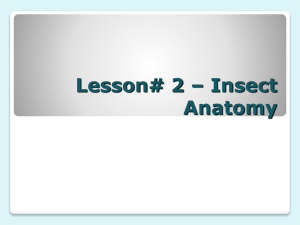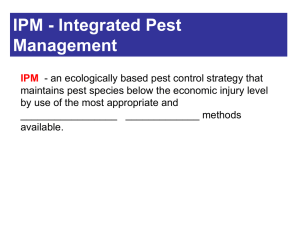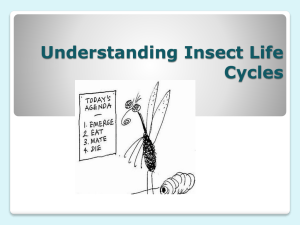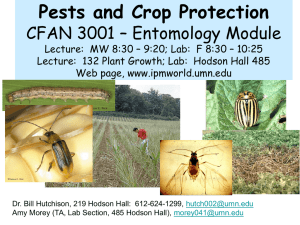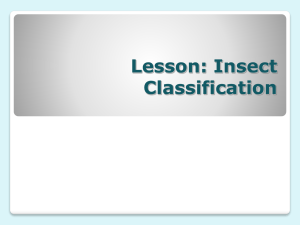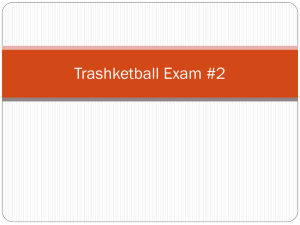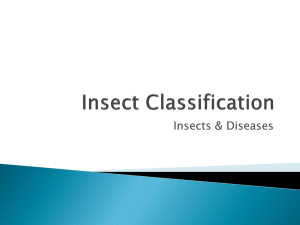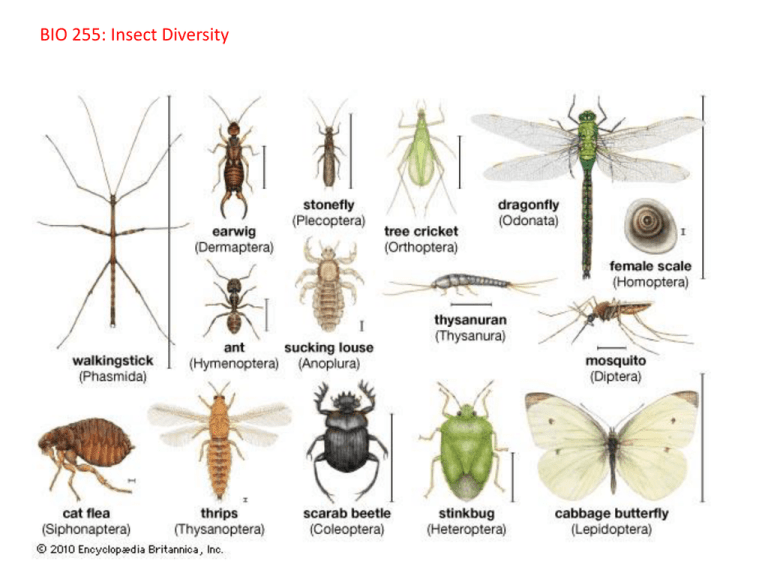
BIO 255: Insect Diversity
I. Insect Diversity
A. In Taxonomic Context
I. Insect Diversity
A. In Taxonomic Context
B. In Ecological Context
- aquatic/terrestrial (not marine)
I. Insect Diversity
A. In Taxonomic Context
B. In Ecological Context
- aquatic/terrestrial (not marine, though some in estuarine environments)
- Detritivores
I. Insect Diversity
A. In Taxonomic Context
B. In Ecological Context
- aquatic/terrestrial (not marine, though some in estuarine environments)
- Detritivores
- Predators
I. Insect Diversity
A. In Taxonomic Context
B. In Ecological Context
- aquatic/terrestrial (not marine, though some in estuarine environments)
- Detritivores
- Predators
- Herbivores
I. Insect Diversity
A. In Taxonomic Context
B. In Ecological Context
- aquatic/terrestrial (not marine, though some in estuarine environments)
- Detritivores
- Predators
- Herbivores
- Pollinators
I. Insect Diversity
A. In Taxonomic Context
B. In Ecological Context
- aquatic/terrestrial (not marine, though some in estuarine environments)
- Detritivores
- Predators
- Herbivores
- Pollinators
- Parasites
I. Insect Diversity
A. In Taxonomic Context
B. In Ecological Context
- aquatic/terrestrial (not marine, though some in estuarine environments)
- Detritivores
- Predators
- Herbivores
- Pollinators
- Parasites
“Little things that
run the world”
I. Insect Diversity
A. In Taxonomic Context
B. In Ecological Context
II. Evolution and Phylogeny
A. Arthropod Phylogeny
I. Insect Diversity
A. In Taxonomic Context
B. In Ecological Context
II. Evolution and Phylogeny
A. Arthropod Phylogeny
B. Insect Evolution
- oldest fossils: Rhyniella praecursor – 400mya Devonian
I. Insect Diversity
A. In Taxonomic Context
B. In Ecological Context
II. Evolution and Phylogeny
A. Arthropod Phylogeny
B. Insect Evolution
- oldest fossils: Rhyniognatha hirsti
also from Rhynie Chert – 400 mya
II. Evolution and Phylogeny
A. Arthropod Phylogeny
B. Insect Evolution
- Carboniferous (359-300 mya) Radiation
II. Evolution and Phylogeny
A. Arthropod Phylogeny
B. Insect Evolution
- Carboniferous (359-300 mya) Radiation
Arthropleura -largest terrestrial
arthropod - 2m
- radiation of insects
- evolution of flight
Meganeura monyi - largest insect ever
wingspan of 70 cm
II. Evolution and Phylogeny
A. Arthropod Phylogeny
B. Insect Evolution
- Evolution of seed plants in Permian
(300-250 mya) and their dominance in
Mesozoic led to radiation of
herbivorous groups (Orthoptera,
Hemiptera and Coleoptera)
II. Evolution and Phylogeny
A. Arthropod Phylogeny
B. Insect Evolution
- Evolution of flowering plants in
Cretaceous (late Mesozoic – 144-65
mya) led to radiation of pollinating
groups (Diptera, Hymenoptera,
Coleoptera, and Lepidoptera)
III. Insect Classification
Entognatha
Ectognatha
Pterygota
Neoptera
Endopterygota
(complete metamorphosis)
Polyphyletic
III. Insect Classification
A. Entognatha (Mouthparts concealed in ‘pouch’)
1. Order Protura (Proturans)
- minute, unpigmented, no antennae; use forelegs as sensory apparati. Eyes absent or
reduced
Detritivorous and fungivorous – in moist soil
III. Insect Classification
A. Entognatha (Mouthparts concealed in ‘pouch’)
1. Order Protura (Proturans)
2. Order Collembola (springtails)
- minute, with antennae. Forked “furcula” folded beneath, and a thoracic knob. May be
abundant. Detritivores.
III. Insect Classification
A. Entognatha (Mouthparts concealed in ‘pouch’)
1. Order Protura (Proturans)
2. Order Collembola (springtails)
3. Order Diplura (Diplurans)
- small, with long antennae. Two caudal processes, either long or short and pincer-like.
Those with pincers are predators, using them to pinch small arthropods. Others are
detritivores.
III. Insect Classification
A. Entognatha (Mouthparts concealed in ‘pouch’)
B. Ectognatha (Mouthparts visible)
- Apterygota: Wingless True Insects
1. Order Microcoryphia (Jumping Bristletails)
- Look like bristletails (thysanura) with three caudal appendages, but a higher, rounded
back and contiguous large compound eyes. Feed on algae lichens, mosses. Jump up
to a foot, although the largest is only 15mm. Styli on abdominal segments.
III. Insect Classification
Entognatha
Ectognatha
Pterygota
Neoptera
Endopterygota
(complete metamorphosis)
Polyphyletic
III. Insect Classification
A. Entognatha (Mouthparts concealed in ‘pouch’)
B. Ectognatha (Mouthparts visible)
- Apterygota: Wingless True Insects
1. Order Microcoryphia (Jumping Bristletails)
2. Order Thysanura (Bristletails/Silverfish)
- Flattened and larger, with well separated eyes and styli on abdominal segments. Three
caudal appendages and scales (like butterflies) on segments. Detritivores.
III. Insect Classification
Entognatha
Ectognatha
Pterygota
Neoptera
Endopterygota
(complete metamorphosis)
Polyphyletic
III. Insect Classification
A. Entognatha (Mouthparts concealed in ‘pouch’)
B. Ectognatha (Mouthparts visible)
- Pterygota: Winged True Insects
- Paleoptera: “Ancient Wing” – unable to fold the wing down onto back
1. Order Ephemeroptera (Mayflies)
III. Insect Classification
A. Entognatha (Mouthparts concealed in ‘pouch’)
B. Ectognatha (Mouthparts visible)
- Pterygota: Winged True Insects
- Paleoptera: “Ancient Wing” – unable to fold the wing down onto back
1. Order Ephemeroptera (Mayflies)
2. Order Odonata (Dragonflies and Damselflies)
III. Insect Classification
Entognatha
Ectognatha
Pterygota
Neoptera
Endopterygota
(complete metamorphosis)
Polyphyletic
III. Insect Classification
A. Entognatha (Mouthparts concealed in ‘pouch’)
B. Ectognatha (Mouthparts visible)
- Pterygota: Winged True Insects
- Paleoptera: “Ancient Wing” – unable to fold the wing down onto back
- Neoptera: “Modern Wing” – wings fold flat onto back
- Exopterygota (simple metamorphosis)
- Orthopteroida (simple metamorphosis, mandibulate mouthparts, large anal
lobe in the hind wing)
(Blattaria and Mantodea)
III. Insect Classification
A. Entognatha (Mouthparts concealed in ‘pouch’)
B. Ectognatha (Mouthparts visible)
- Pterygota: Winged True Insects
- Paleoptera: “Ancient Wing” – unable to fold the wing down onto back
- Neoptera: “Modern Wing” – wings fold flat onto back
- Exopterygota (simple metamorphosis)
- Orthopteroida (simple metamorphosis, mandibulate mouthparts, large anal
lobe in the hind wing)
1. Order Phasmatodea (Walking sticks)
III. Insect Classification
A. Entognatha (Mouthparts concealed in ‘pouch’)
B. Ectognatha (Mouthparts visible)
- Pterygota: Winged True Insects
- Paleoptera: “Ancient Wing” – unable to fold the wing down onto back
- Neoptera: “Modern Wing” – wings fold flat onto back
- Exopterygota (simple metamorphosis)
- Orthopteroida (simple metamorphosis, mandibulate mouthparts, large anal
lobe in the hind wing)
1. Order Phasmatodea (Walking sticks)
2. Order Orthoptera (Grasshoppers, crickets, and katydids)
III. Insect Classification
B. Ectognatha (Mouthparts visible)
- Pterygota: Winged True Insects
- Neoptera: “Modern Wing” – wings fold flat onto back
- Exopterygota (simple metamorphosis)
- Orthopteroida (simple metamorphosis, mandibulate mouthparts, large anal
lobe in the hind wing)
1. Order Phasmatodea (Walking sticks)
2. Order Orthoptera (Grasshoppers, crickets, and katydids)
3. Order Mantodea (Mantids)
III. Insect Classification
B. Ectognatha (Mouthparts visible)
- Pterygota: Winged True Insects
- Neoptera: “Modern Wing” – wings fold flat onto back
- Exopterygota (simple metamorphosis)
- Orthopteroida (simple metamorphosis, mandibulate mouthparts, large anal
lobe in the hind wing)
1. Order Phasmatodea (Walking sticks)
2. Order Orthoptera (Grasshoppers, crickets, and katydids)
3. Order Mantodea (Mantids)
4. Order Blattaria (Roaches)
III. Insect Classification
B. Ectognatha (Mouthparts visible)
- Pterygota: Winged True Insects
- Neoptera: “Modern Wing” – wings fold flat onto back
- Exopterygota (simple metamorphosis)
- Orthopteroida (simple metamorphosis, mandibulate mouthparts, large anal
lobe in the hind wing)
1. Order Phasmatodea (Walking sticks)
2. Order Orthoptera (Grasshoppers, crickets, and katydids)
3. Order Mantodea (Mantids)
4. Order Blattaria (Roaches)
5. Order Isoptera (Termites)
III. Insect Classification
B. Ectognatha (Mouthparts visible)
- Pterygota: Winged True Insects
- Neoptera: “Modern Wing” – wings fold flat onto back
- Exopterygota (simple metamorphosis)
- Orthopteroida (simple metamorphosis, mandibulate mouthparts, large anal
lobe in the hind wing)
1. Order Phasmatodea (Walking sticks)
2. Order Orthoptera (Grasshoppers, crickets, and katydids)
3. Order Mantodea (Mantids)
4. Order Blattaria (Roaches)
5. Order Isoptera (Termites)
6. Order Dermaptera (Earwigs)
III. Insect Classification
B. Ectognatha (Mouthparts visible)
- Pterygota: Winged True Insects
- Neoptera: “Modern Wing” – wings fold flat onto back
- Exopterygota (simple metamorphosis)
- Orthopteroida (simple metamorphosis, mandibulate mouthparts, large anal
lobe in the hind wing)
1. Order Phasmatodea (Walking sticks)
2. Order Orthoptera (Grasshoppers, crickets, and katydids)
3. Order Mantodea (Mantids)
4. Order Blattaria (Roaches)
5. Order Isoptera (Termites)
6. Order Dermaptera (Earwigs)
7. Order Plectoptera (Stoneflies)
III. Insect Classification
Entognatha
Ectognatha
Pterygota
Neoptera
Endopterygota
(complete metamorphosis)
Polyphyletic
III. Insect Classification
A. Entognatha (Mouthparts concealed in ‘pouch’)
B. Ectognatha (Mouthparts visible)
- Pterygota: Winged True Insects
- Paleoptera: “Ancient Wing” – unable to fold the wing down onto back
- Neoptera: “Modern Wing” – wings fold flat onto back
- Exopterygota (simple metamorphosis)
- Orthopteroida (simple metamorphosis, mandibulate mouthparts, large anal
lobe in the hind wing)
(Blattaria and Mantodea)
III. Insect Classification
Entognatha
Ectognatha
Pterygota
Neoptera
Endopterygota
(complete metamorphosis)
Polyphyletic
III. Insect Classification
A. Entognatha (Mouthparts concealed in ‘pouch’)
B. Ectognatha (Mouthparts visible)
- Pterygota: Winged True Insects
- Paleoptera: “Ancient Wing” – unable to fold the wing down onto back
- Neoptera: “Modern Wing” – wings fold flat onto back
- Exopterygota (simple metamorphosis)
- Orthopteroida
- Hemipteroida (simple metamorphosis, sucking mouthparts, no lobe in wing)
1. Order Hemiptera (Bugs, Cicadas, planthoppers, aphids)
III. Insect Classification
A. Entognatha (Mouthparts concealed in ‘pouch’)
B. Ectognatha (Mouthparts visible)
- Pterygota: Winged True Insects
- Paleoptera: “Ancient Wing” – unable to fold the wing down onto back
- Neoptera: “Modern Wing” – wings fold flat onto back
- Exopterygota (simple metamorphosis)
- Orthopteroida
- Hemipteroida (simple metamorphosis, sucking mouthparts, no lobe in wing)
1. Order Hemiptera (Bugs, Cicadas, planthoppers, aphids)
2. Order Psocoptera (Booklice)
III. Insect Classification
A. Entognatha (Mouthparts concealed in ‘pouch’)
B. Ectognatha (Mouthparts visible)
- Pterygota: Winged True Insects
- Paleoptera: “Ancient Wing” – unable to fold the wing down onto back
- Neoptera: “Modern Wing” – wings fold flat onto back
- Exopterygota (simple metamorphosis)
- Orthopteroida
- Hemipteroida (simple metamorphosis, sucking mouthparts, no lobe in wing)
1. Order Hemiptera (Bugs, Cicadas, planthoppers, aphids)
2. Order Psocoptera (Booklice)
3. Order Phthiraptera (Lice)
III. Insect Classification
A. Entognatha (Mouthparts concealed in ‘pouch’)
B. Ectognatha (Mouthparts visible)
- Pterygota: Winged True Insects
- Paleoptera: “Ancient Wing” – unable to fold the wing down onto back
- Neoptera: “Modern Wing” – wings fold flat onto back
- Exopterygota (simple metamorphosis)
- Orthopteroida
- Hemipteroida (simple metamorphosis, sucking mouthparts, no lobe in wing)
1. Order Hemiptera (Bugs, Cicadas, planthoppers, aphids)
2. Order Psocoptera (Booklice)
3. Order Phthiraptera (Lice)
4. Order Thysanoptera (Thrips)
III. Insect Classification
Entognatha
Ectognatha
Pterygota
Neoptera
Endopterygota
(complete metamorphosis)
Polyphyletic
III. Insect Classification
Entognatha
Ectognatha
Pterygota
Neoptera
Endopterygota
(complete metamorphosis)
Polyphyletic
-Neoptera: “Modern Wing” – wings fold flat onto back
- Exopterygota (simple metamorphosis)
- Orthopteroidea
- Hemipteroidea
- Endopterygota (complete metamophosis – larvae)
- Neuropteroida
1. Order Neuroptera (Lacewings and kin)
2. Order Coleoptera (Beetles)
-Neoptera: “Modern Wing” – wings fold flat onto back
- Exopterygota (simple metamorphosis)
- Orthopteroidea
- Hemipteroidea
- Endopterygota (complete metamophosis – larvae)
- Neuropteroida
1. Order Neuroptera (Lacewings and kin)
III. Insect Classification
Entognatha
Ectognatha
Pterygota
Neoptera
Endopterygota
(complete metamorphosis)
Polyphyletic
-Neoptera: “Modern Wing” – wings fold flat onto back
- Exopterygota (simple metamorphosis)
- Orthopteroidea
- Hemipteroidea
- Endopterygota (complete metamophosis – larvae)
- Neuropteroida
- Hymenopteroida
1. Order Hymenoptera (Sawflies, bees, wasps, and ants)
III. Insect Classification
Entognatha
Ectognatha
Pterygota
Neoptera
Endopterygota
(complete metamorphosis)
Polyphyletic
-Neoptera: “Modern Wing” – wings fold flat onto back
- Exopterygota
- Endopterygota (complete metamophosis – larvae)
- Neuropteroida
- Hymenopteroida
- Panorpoida
-Neoptera: “Modern Wing” – wings fold flat onto back
- Exopterygota (simple metamorphosis)
- Orthopteroidea
- Hemipteroidea
- Endopterygota (complete metamophosis – larvae)
- Neuropteroida
- Hymenopteroida
- Panorpoida
1. Order Trichoptera (Caddisflies)
-Neoptera: “Modern Wing” – wings fold flat onto back
- Exopterygota (simple metamorphosis)
- Orthopteroidea
- Hemipteroidea
- Endopterygota (complete metamophosis – larvae)
- Neuropteroida
- Hymenopteroida
- Panorpoida
1. Order Trichoptera (Caddisflies)
2. Order Lepidoptera (Butterflies and Moths)
-Neoptera: “Modern Wing” – wings fold flat onto back
- Exopterygota
- Endopterygota (complete metamophosis – larvae)
- Neuropteroida
- Hymenopteroida
- Panorpoida
1. Order Trichoptera (Caddisflies)
2. Order Lepidoptera (Butterflies and Moths)
3. Order Siphonaptera (Fleas)
-Neoptera: “Modern Wing” – wings fold flat onto back
- Exopterygota
- Endopterygota (complete metamophosis – larvae)
- Neuropteroida
- Hymenopteroida
- Panorpoida
1. Order Trichoptera (Caddisflies)
2. Order Lepidoptera (Butterflies and Moths)
3. Order Siphonaptera (Fleas)
4. Order Mecoptera (Scorpionflies)
-Neoptera: “Modern Wing” – wings fold flat onto back
- Exopterygota
- Endopterygota (complete metamophosis – larvae)
- Neuropteroida
- Hymenopteroida
- Panorpoida
1. Order Trichoptera (Caddisflies)
2. Order Lepidoptera (Butterflies and Moths)
3. Order Siphonaptera (Fleas)
4. Order Mecoptera (Scorpionflies)
5. Order Diptera (Flies)
III. Insect Classification
Entognatha
Ectognatha
Pterygota
Neoptera
Endopterygota
(complete metamorphosis)
IV. Insect Anatomy
IV. Insect Anatomy
IV. Insect Anatomy
Insect head site
IV. Insect Anatomy
IV. Insect Anatomy
III. Insect Classification
A. Entognatha (Mouthparts concealed in ‘pouch’)
1. Order Protura (Proturans)
- minute, unpigmented, no antennae; use forelegs as sensory apparati. Eyes absent or
reduced
Detritivorous and fungivorous – in moist soil
ORDER: PROTURA
- anamorphosis: hatch with 9 abdominal
segments, and adds a segment with each
molt; most families have 5 molts, one has 6
ORDER: PROTURA
- anamorphosis: hatch with 9 abdominal
segments, and adds a segment with each
molt
- no eyes
- some families have no spiracles/trachea
ORDER: PROTURA
- anamorphosis: hatch with 9 abdominal
segments, and adds a segment with each
molt
- no eyes
- some families have no spiracles/trachea
- first species discovered in 1907
- 500 species in nine families worldwide
- 20 species in 3 families in NA
Early woodcut by Berlese (1907)
ORDER: PROTURA
Eosentomidae (8 species)
Tracheate
Abdominal appendages 2-segmented
ORDER: PROTURA
Eosentomidae (8 species)
Acerentomidae (9 species)
Lack trachea and spiracles
III. Insect Classification
A. Entognatha (Mouthparts concealed in ‘pouch’)
1. Order Protura (Proturans)
2. Order Collembola (springtails)
- minute, with antennae. Forked “furcula” folded beneath, and an abdominal knob
(“collophore”). May be very abundant. Detritivores and fungivores.
III. Insect Classification
A. Entognatha (Mouthparts concealed in ‘pouch’)
1. Order Protura (Proturans)
2. Order Collembola (springtails)
- minute, with antennae. Forked “furcula” folded beneath, and an abdominal knob
(“collophore”). May be very abundant. Detritivores and fungivores.
III. Insect Classification
A. Entognatha (Mouthparts concealed in ‘pouch’)
1. Order Protura (Proturans)
2. Order Collembola (springtails)
Hypogastruridae -- the largest family in the order. These are small, plump
hexapods that may lack compound eyes or a springtail (furcula). Includes the
snowflea, Hypogastrura nivicola.
III. Insect Classification
A. Entognatha (Mouthparts concealed in ‘pouch’)
1. Order Protura (Proturans)
2. Order Collembola (springtails)
Isotomidae -- second largest family in the order. These hexapods are elongate
and lack scales on the upper surface of the body.
III. Insect Classification
A. Entognatha (Mouthparts concealed in ‘pouch’)
1. Order Protura (Proturans)
2. Order Collembola (springtails)
Entomobryidae -- common soil-dwellers. The fourth abdominal segment is
significantly longer than the others.
III. Insect Classification
A. Entognatha (Mouthparts concealed in ‘pouch’)
1. Order Protura (Proturans)
2. Order Collembola (springtails)
Sminthuridae -- body globular in shape. The family includes the garden springtail
(Bourletiella hortensis) which occasionally damages plant seedlings.
III. Insect Classification
A. Entognatha (Mouthparts concealed in ‘pouch’)
1. Order Protura (Proturans)
2. Order Collembola (springtails)
3. Order Diplura (Diplurans)
- small, with long antennae. Two caudal processes, either long or short and pincer-like.
Those with pincers are predators, using them to pinch small arthropods. Others are
detritivores.
- ~800 species in 5 families
III. Insect Classification
A. Entognatha (Mouthparts concealed in ‘pouch’)
1. Order Protura (Proturans)
2. Order Collembola (springtails)
3. Order Diplura (Diplurans)
Campodeidae -- approximately 34 North American species, all of which have long
cerci (10-segments).
Japygidae -- 28 North American species, all of which have short (unsegmented)
cerci in the form of pincers (forceps).
III. Insect Classification
Entognatha
Ectognatha
Pterygota
Neoptera
Endopterygota
(complete metamorphosis)
Polyphyletic
III. Insect Classification
A. Entognatha (Mouthparts concealed in ‘pouch’)
B. Ectognatha (Mouthparts visible)
- Apterygota: Wingless True Insects
1. Order Microcoryphia (Jumping Bristletails)
- Look like bristletails (thysanura) with three caudal appendages, but a higher, rounded
back and contiguous large compound eyes. Feed on algae lichens, mosses. Jump up
to a foot, although the largest is only 15mm. Styli on abdominal segments.
Family Machilidae
III. Insect Classification
A. Entognatha (Mouthparts concealed in ‘pouch’)
B. Ectognatha (Mouthparts visible)
- Apterygota: Wingless True Insects
1. Order Microcoryphia (Jumping Bristletails)
2. Order Thysanura (Bristletails/Silverfish)
- Flattened and larger, with well separated eyes and styli on abdominal segments. Three
caudal appendages and scales (like butterflies) on segments. Detritivores.
III. Insect Classification
A. Entognatha (Mouthparts concealed in ‘pouch’)
B. Ectognatha (Mouthparts visible)
- Apterygota: Wingless True Insects
1. Order Microcoryphia (Jumping Bristletails)
2. Order Thysanura (Bristletails/Silverfish)
Family Lepismatidae
Firebrat – Thermobia domestica
Live in hot areas, near furnaces and such
Firebrats have been known to live more than 6 years -- through 60 instars. It has been
suggested that frequent molting is an adaptation that reduced the risk of infection by
parasitic fungi.
III. Insect Classification
A. Entognatha (Mouthparts concealed in ‘pouch’)
B. Ectognatha (Mouthparts visible)
- Apterygota: Wingless True Insects
1. Order Microcoryphia (Jumping Bristletails)
2. Order Thysanura (Bristletails/Silverfish)
Family Lepismatidae
Silverfish – Lepisma saccharina
III. Insect Classification
Entognatha
Ectognatha
Pterygota
Neoptera
Endopterygota
(complete metamorphosis)
Polyphyletic
Pinning and Labeling Insects
Pinning and Labeling Insects
Pinning and Labeling Insects
Pinning and Labeling Insects
384600 E 3893800 N (UTM)
USA, South Carolina, Greenville Co.
East slope Hogback Mtn. FF# 423
3 August 2011
A. Schulz

